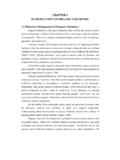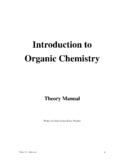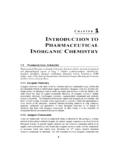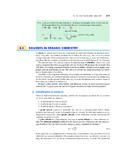Transcription of Unit 12: Introduction to Organic and Biochemistry Ch ...
1 2011 #100 Notes Unit 12: Introduction to Organic and Biochemistry Ch. Organic / Biochemistry I. Alkanes, CnH2n+2 (saturated hydrocarbons: no C=C or C C) *always 4 bonds on carbon # Carbons parent chain name 1 methane CH4 2 ethane CH3CH3 3 propane CH3CH2CH3 4 butane CH3CH2CH2CH3 5 pentane CH3CH2CH2CH2CH3 6 hexane 7 heptane 8 octane 9 nonane 10 decane 2011 A) Substituents B) Other Groups.
2 -F (fluoro), -Cl (chloro), -Br (bromo), -I (iodo), -NO2 (nitro), -NH2 (amino), -OH (hydroxyl). C) Naming: 1) Find the longest connected chain of carbon atoms (=skeleton). 2) Number the chain from #1 end, starting with the end having the most substituents. (Substituents should have the smallest number possible.) 3) Name: (# of carbon)-(substituent) ..(parent chain) Ex. 1) 3-methyl hexane 2011 Ex. 2) 2-chloro-4-ethyl heptane *List substituents in alphabetical order, not in order of numbers. Ex. 3) 2,5-dibromo-3-methyl hexane *For identical: 2 = di, 3 = tri, 4 = tetra Ex. 4) 3,3-difluoro heptane 2011 Ex. 5) cyclopropane Ex. 6) 1-chloro-2-methyl cyclobutane Ex. 7) Draw 2-chloro-3 -isopropyl-5-methyl octane Ex. 8) Draw 2-bromo-5-chloro-6,6-diethyl-3 -methyl-4-tert-butyl nonane 2011 #101 Notes II.
3 Alkenes, CnH2n (unsaturated hydrocarbons, C=C) A) Naming: 1) Find the longest carbon chain containing the double bond. 2) The double bond gets the smallest number possible. (other substituents don t matter) 3) The smallest number of the double bond goes in front of the parent name. replace ane with -ene 4) Treat substituents as before. Ex. 1) 5-bromo-3-heptene Ex. 2) 2,7-dichloro-6-ethyl-4-nonene 2011 Ex. 3) Cis/Trans Isomers cis-2 -pentene trans-2-pentene ) 2,4-hexadiene Cycloalkenes: Start numbering at the double bond and go across it, so that the nearest substituent has the lowest number possible. Ex. 1) 3-chloro cyclopentene {3-chloro-1-cyclopentene (1 is understood, if not written)} 2011 Ex.
4 2) 2-hydroxyl-3-methyl-5 - propyl-1,3-cyclohexadiene III. Aromatic Compounds, CnHn -6 member ring with alternating double bonds benzene phenyl **Each bond is 1 bonds! (as substituent) Ex. 1) 1,2-dibromo benzene 1-bromo-3 -chloro benzene 1-fluoro-4 -iodo benzene ortho-dibromo benzene meta-bromochloro benzene para-fluoroiodo benzene o-dibromo benzene m-bromochloro benzene p-fluoroiodo benzene 2011 Ex. 2) 2-phenyl-undecane toluene phenol ortho-xylene (2 methyls) styrene naphthalene anthracene 2011 #102 Notes IV. Functional Groups -alkenes from before (C=C) A) Alkynes Ex. 1) 4-nitro-2-pentyne B) Alcohols R equals the carbon/hydrogen chain *OH gets the smallest number Ex.
5 1) 2,5-dimethyl-3-hexanol C) Ethers short chain, oxy, then long chain Ex. 1) ethoxypropane D) Aldehydes Ex. 1) 5-bromo hexanal 2011 E) Ketones C=O gets the smallest # possible Ex. 1) 7-bromo-3-nonanone F) Carboxylic Acids Ex. 1) 2,3-dimethyl pentanoic acid G) Esters Ex. 1) methyl propanoate substituent 2011 H) Amides (bond between amino acids in proteins) Ex. 1) N,N-methyl ethyl propanamide I) Amines Ex. 1) 2-amino-5-methyl heptane 1o (primary) amine Ex. 2) N-ethyl propanamine 2o (secondary) amine Ex. 3) N-propyl, N-isopropyl butanamine 3o (tertiary) amine 2011 #103 Notes Ch. Biochemistry I. Proteins The 20 amino acids are the building blocks of all proteins. carboxylic acid amino acid R = H, CH3, etc. (see textbook for amino acids) peptide linkage (amide) This molecule is a dipeptide, a natural polymer.
6 Collagen is 3 protein chains twisted together to form a super helix. (H-bonding occurs between the chains.) The amino acid cystein, R = CH2SH can form links between chains too. CH2 S S CH2 (The disulfide linkage is a true bond, unlike a H-bond.) Proteins: Include collagen (tendons, muscles), hemoglobin (carries O2 in blood), antibodies, enzymes, some hormones etc. 2011 II. Carbohydrates such as starch and cellulose are polymers of simple sugars (monosaccharides). fructose (honey, fruit), glucose, ribose, galactose sucrose (table sugar) is a disaccharide of glucose and fructose. D-glucose D-fructose The orientation of the attack determines or . Starch (plant carbohydrate reservoir) is a polymer of -D-glucose. Cellulose (plant fiber, cotton) is a polymer of -D-glucose. 2011 III. Lipids (Fats, Fatty Acids) CH3(CH2)nCO2H n = 16 stearic acid **saturated fats (alkanes- full of hydrogen) n = 2 & 4 butter **unsaturated fats (alkenes- hydrogen can add on C==C) n = 18 peanut oil n = 10 coconut oil IV.
7 Nucleic Acids DNA deoxyribonucleic acid (molecular masses = several billion g/mol) RNA ribonucleic acid (20,000 40,000 g/mol These sugars are bonded together with phosphate linkages to bases and the bases stick together to make a double helix. 2011 For cell division: 1) DNA has a double helix with complementary bases on the two strands. (cysteine guanine, and thymine adenine) 2) The DNA unwinds and each half gets new partners, thus the DNA is replicated to transfer the genetic code when the cell divides. Protein Synthesis: 1) Part of the DNA, a gene, holds the codes for a specific protein. 2) A complementary m-RNA (messenger) strand is copied and transferred to the cytoplasm. A t-RNA (transfer) finds bases and makes a protein complementary to the m-RNA. (It makes a copy of the part of the DNA that was copied, like a copying machine.) *End of Notes*












